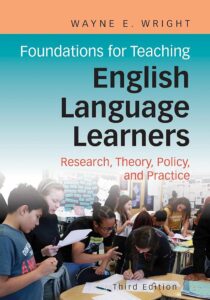Is Chinese bad?
When I first started teaching English in Taiwan about 15 years ago, the golden rule at every school that I taught at was “NO CHINESE”. At these schools, the worst thing a student, or God forbid, a teacher could do was speak Chinese. School management would tell me that I could never let students know that I understood Chinese because then students would want to speak to me in Chinese all the time and would never practice their English. Because of this, many students and teachers have the idea pressed into their brains that Chinese is bad.
This monolingual approach to teaching English is still popular to this day. In fact, “Use English” is still at the top of Englist’s official list of class rules. Nonetheless, recent research reveals that strict “English only” approaches aren’t the most effective way to help students learn English, and that in our context, Chinese can be helpful.
Translanguaging
 Every other week, all of the teachers at Englist get together to read and discuss books and articles related to teaching and education. Last year, Mr. Hatch suggested that we all read a book called Foundations for Teaching English Language Learners – Research, Theory, Policy and Practice by Wayne E. Wright. This book was part of the required reading for his CSU Fullerton M.S.Ed. program, and we read it together because a large portion of the book is directly related to what we do at Englist.
Every other week, all of the teachers at Englist get together to read and discuss books and articles related to teaching and education. Last year, Mr. Hatch suggested that we all read a book called Foundations for Teaching English Language Learners – Research, Theory, Policy and Practice by Wayne E. Wright. This book was part of the required reading for his CSU Fullerton M.S.Ed. program, and we read it together because a large portion of the book is directly related to what we do at Englist.
One thing from the book that stood out to me was the idea of translanguaging which is a relatively new way to think of how we use and teach languages. This idea intrigued me because it goes against a lot of what I had been taught over the past 15 years.
As a theory, translanguaging means that we don’t have separate compartments for different languages in our brains. Rather, all of our languages are retained within the same system and we are able to dynamically switch between them to help us solve problems and make sense of the world around us. As a pedagogical approach, translanguaging describes the practice of allowing and encouraging students to use their first language to help them learn and understand a second language.
Benefits of translanguaging
Researchers have already identified some benefits of using translanguaging in English language teaching:
1. Enhances comprehension and enjoyment
Allowing students to use their first language to help them navigate challenging texts or understand complex ideas reduces cognitive load and allows students to focus on important lesson points. Something as simple as providing an English-Chinese glossary for students can greatly increase student comprehension and enjoyment of a text.
2. Supports cognitive development
Switching between English and Chinese improves students’ cognitive flexibility and helps students learn how to use language not just for communication, but also for thinking and problem-solving. One activity that I do with students is ask them to use Chinese to explain something that they read about, and then use English to explain it once more. Tasks like this force students to closely analyze and evaluate what they’ve read, and it also allows me to evaluate how well they understand the material.
3. Increases engagement and participation
I have personally felt the deep frustration and embarrassment of being unable to fully express myself in Chinese, so I can understand why some students prefer to remain silent or disengaged in English-only class settings. Translanguaging provides an inclusive and supportive learning environment which can boost student confidence and willingness to participate in class. Letting students use Chinese to bridge the gaps in their English ability allows them to be themselves and gradually learn how to say what they want to say in English.
4. Promotes language awareness
When students go back and forth between languages, they are forced to think about each language which leads to students becoming aware of and ultimately having a deeper understanding of grammatical structures and vocabulary in each language.
5. Facilitates language transfer and builds on prior knowledge
A lot of research has shown that background knowledge is one of the most important factors when it comes to comprehending a reading text. By leveraging their first language, students can transfer skills, strategies, and knowledge from their first language to English. For example, they can apply grammar rules, vocabulary, and comprehension strategies that are similar across languages, which accelerates their progress in learning English.
Translanguaging in practice
After learning about the benefits of translanguaging, the first thought that came to my mind was that I had been handicapping my students the whole time. I started implementing translanguaging practices into my classroom as soon as I could by including Chinese translations for certain vocabulary words and allowing students to use Chinese when they absolutely needed to.
So far the results have been positive and I have observed some of the benefits listed above. The most noticeable benefits so far are increased engagement and participation, as well as improved classroom collaboration. It is a joy to see students, who used to be quiet or apathetic in class, finally feel comfortable and motivated enough to share their complex and creative ideas both orally and in their written assignments. Pair and group work is also much more dynamic and lively now. Instead of a few students carrying the load for each group, I’m seeing more collaboration and debate happening. For these students, it was never a matter of not having anything to say. It was just a matter of not being able to say it.
Concerns about translanguaging
Many school managers, teachers, and parents worry that allowing students to speak Chinese in class is like opening a floodgate that will lead to students ignoring English and only speaking Chinese in class. Sure, if I told my students that they could just speak Chinese freely whenever they want, I’m sure a good portion of them would do just that.
This is why “Use English” is still at the top of Englist’s class rules. It comes down to how translanguaging is framed and introduced to students.
In my class, after I’ve hammered in the importance of practicing English in our classroom, I tell students that I may occasionally use Chinese to explain something and that students can also use Chinese when it is absolutely necessary to explain an idea they couldn’t otherwise. I emphasize that Chinese should only be used as a tool to help learn new words, express complex ideas, or understand difficult texts. When students are doing group work, I make sure that I walk around and monitor student conversations to ensure that they are either speaking English or using Chinese constructively.
Of course, some students have tried to push the limits to see what they can get away with, but I always intervene and ensure students remain consistent in using English. Implementing translanguaging in the classroom requires vigilance on the teacher’s part, especially at the beginning, but from my experience so far, it has been worth the extra effort.
Chinese is good
We need to eliminate the stigma associated with using Chinese in English-learning environments because based on what I’ve read and on my own observations, Chinese is good when used as a tool to teach and learn English. The great thing is that all Taiwanese students already have this powerful language-learning tool at their disposal. We just need to let them use it.
– Mr. Jason Chen
Sources:
-
The Bell Foundation. “Great Ideas: Translanguaging.” Retrieved from https://www.bell-foundation.org.uk/resources/great-ideas/translanguaging/
-
The Bell Foundation. “Translanguaging: How to Use Students’ Own Languages to Enhance Learning.” Retrieved from https://www.bell-foundation.org.uk/news/translanguaging-how-to-use-students-own-languages-to-enhance-learning/
-
Heinemann. “What Is Translanguaging?” Retrieved from https://blog.heinemann.com/what-is-translanguaging
-
Center for Applied Linguistics. “Translanguaging: Theory, Concept, Practice, Stance… or All of the Above?” Retrieved from https://www.cal.org/wp-content/uploads/2022/05/TranslanguagingTheoryConceptPracticeStance%E2%80%A6orAlloftheAbove_CALCommentary.pdf
-
EAL Journal. “What Is Translanguaging?” Published July 26, 2016. Retrieved from https://ealjournal.org/2016/07/26/what-is-translanguaging/
-
Education Week. “What Is Translanguaging, and How Is It Used in the Classroom?” Published July 2023. Retrieved from https://www.edweek.org/teaching-learning/what-is-translanguaging-and-how-is-it-used-in-the-classroom/2023/07
-
Wikipedia. “Translanguaging – Translanguaging Pedagogy.” Retrieved from https://en.wikipedia.org/wiki/Translanguaging#Translanguaging_Pedagogy
-
English Language Learners Book (author and publisher not specified).
-
ResearchGate. “Translanguaging and EFL Teaching.” Retrieved from https://www.researchgate.net/publication/384131821_Translanguaging_and_EFL_Teaching
-
ScienceDirect. “Translanguaging Pedagogy Creates a Space for Multilingual Meaning Making.” Retrieved from https://www.sciencedirect.com/science/article/abs/pii/S014717672400052X

